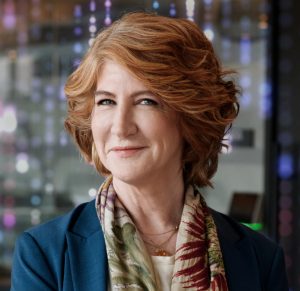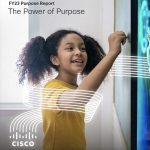Cisco’s purpose is to Power an Inclusive Future for All, and this includes ensuring a sustainable and regenerative future for our planet. We’re leveraging our scale and innovation to help ensure that our increasingly digital future is sustainable, fair, and resilient. We are doing this by decarbonizing our operations, supply chain, and products; transitioning to renewable energy; and helping customers and communities reduce their impacts and adapt to a changing world.
Mary de Wysocki, Cisco’s first Chief Sustainability Officer (CSO), shares her experience designing for impact, her objectives as she leads Cisco’s sustainability efforts, and how we can work together to create more sustainable and resilient communities.
Before stepping into this role, you led Corporate Social Responsibility (CSR), education, and Environmental, Social, and Governance (ESG) initiatives for Cisco. How did that experience provide a foundation for the work you are focusing on today?

Mary: The learnings I’ve had on a purely social impact side over the last 20 years have allowed me to understand the philosophy of shared value, which was first introduced in 2011. Shared value is how a company can have policies and practices that help to advance the business while also helping individuals and communities where it operates thrive. Think of it like an expanding sphere of influence. Our purpose builds on and deepens this philosophy. When we say we are Powering an Inclusive Future for All, we mean for our business and our communities, our customers, partners, suppliers and other stakeholders. These groups are linked, and we can only achieve an inclusive future for all by all – meaning by working in partnership towards common goals.
There is also the Theory of Change, which is a methodology that explains how taking certain steps can lead to specific changes. Through my prior roles, I’ve seen the difference between theory and what you need to do on the ground to make an impact. For example, after Hurricane Katrina hit the U.S. Gulf Coast, Cisco wanted to help the affected communities, and we felt that the communities couldn’t recover if they didn’t have schools up and working. So, I went to New Orleans and Mississippi to develop Cisco’s 21st Century Schools Initiative with local school districts. This experience allowed me to think beyond the initial response and focus long-term: how can we create resilient communities?
As I shift into my CSO role, I am still thinking about designing for impact. When making public goals, such as positively impacting 1 billion people by 2025, we need to do the work to define the outcomes we are looking for and plan in ways that allow us to pivot, make shifts, and changes. It’s important to understand what it takes to design for impact and how to execute that plan to make that impact a reality.
What are your primary objectives as CSO?
Mary: First, being Cisco´s CSO is an honor and privilege. There is a rich history of hundreds of people across the company who have worked passionately in this space. There has always been a sense of community, and I am proud of the network of people who have been setting and achieving goals, carrying the work forward, and making a real impact in this space.
My primary objective as CSO is to steward environmental sustainability initiatives across Cisco. As we think about our strategy, we’re focusing on how we can decarbonize our business and embed circularity. Equally important is looking at how we can enable sustainable growth and innovation. The greatest opportunity is on helping our customers, partners, and other stakeholders decarbonize their business and embed circularity. Cisco’s technology and ecosystem can play a significant role in the twin transition to a digital and low-carbon economy.
We also want to continue enhancing how we report our progress in an authentic and transparent way. As we think about achieving sustainability goals, it often involves a bit of math. How we measure our actions is underpinned by data, which guides our decisions, and it allows us to create more robust conversations with our stakeholders, so they can also make informed decisions around their sustainability commitments. Data helps understand what sustainability strategies work for one community and how we might shift and adapt for another.
Sustainability is integral to Cisco’s purpose to Power an Inclusive Future for All. Can you tell us more about why a sustainable future includes a more inclusive one?
Mary: We can’t have inclusive and resilient communities if we don’t have a healthy planet. As we look at climate change, the communities impacted the most are our most vulnerable. Research shows that people most affected by climate catastrophic events, like hurricanes or droughts, live in poverty. In the Horn of Africa, over 20 million people’s lives and livelihoods are being threatened by drought, and we are working with our nonprofit partner, Mercy Corps, on a climate adaptation and resilience program to support pastoralist farmers in Northeast Kenya, who have been severely impacted by the drought.
When we talk about the twin transition to a digital and low-carbon economy, how do we enable people to participate? As climate changes, people with resources are the ones who can generally better adapt, move to another location or work from anywhere. However, that is only the case for some. Communities at the forefront of the climate crisis lack the resources to adapt to, respond to, and recover from an increasing number of crises, such as extreme weather, food insecurity, and water scarcity, which leads to mass migration and displacement as well as social instability and conflict.
When you think about the impact of climate on those communities, it comes down to resiliency. Communities that can adapt have rigorous infrastructure and the economic capability to withstand it. They have a sense of community and a citizenry that can adapt and be better prepared. There’s an opportunity to empower people to help them build resilient communities that can better withstand the consequences of climate change.
Cisco’s goal to reach net zero greenhouse gas (GHG) emissions across its value chain (Scopes 1, 2, and 3) by 2040 and near-term targets were approved by the Science Based Targets initiative (SBTi). Can you explain the significance of this?
Mary: The science tells us that to hold global warming to 1.5 degrees Celsius compared to pre-industrial times requires increased ambition and adoption of robust emissions reduction targets at the pace and scale required by climate science. As we think about the role that Cisco can play in decarbonization, we decided to set a public goal around net zero with near term targets that incorporates a methodology around absolute reductions.
Having external validation from SBTi’s new Net-Zero Standard signals that we are committed to the deep emissions reduction that are needed to reduce global warming. To earn SBTi validation, companies are required to reduce their emissions by at least 90%. This requirement means we can’t rely on carbon offsets for more than 10% of our emissions reduction. This external validation demonstrates that our calculations and approach align with accepted standards and creates transparency and trust among stakeholders.
In 2021, the Cisco Foundation committed $100 million over ten years to fund nonprofit grants and impact investing in climate solutions. Could you share more about this strategy?
Mary: This strategy supports early-stage solutions with the potential to scale and be replicable. It aligns with the long-standing social impact investment strategy that we have leveraged from the Cisco Foundation in disaster response, critical human needs, education, and economic empowerment.
When you think about climate, there is a unique role that Cisco can play. Going back to our net zero goal, we know there’s going to be need for changing practices, such as a shift to regenerative agriculture. We know there will be a need for new innovative decarbonization technologies. Whether it is a nonprofit or an interesting area of impact investing, the Cisco Foundation team has the ability to identify how we can nurture them through the cycle of innovation.
An example from our climate portfolio is Vesta, a hybrid nonprofit/public–benefit enterprise. Their solution is to capture carbon from the atmosphere and support coastal resilience by using the mineral olivine. The carbon-capture properties and safety of olivine have been proven in lab settings. But what happens outside the lab? We are investing in that research and enabling Vesta to test it in real-world circumstances to study its effects on wildlife and ecosystems and to see if it is sequestering carbon at the same pace we saw in the lab. This is an excellent example of designing for impact and how we can foster potentially exciting and effective solutions.
We know we can’t do this alone. How is Cisco helping our customers and the world create a more sustainable future?
Mary: We want to provide solutions that help support sustainability goals.
Our customers want to do more, and our ability to continue driving solutions that can improve energy efficiency can support their scope 1 and 2 GHG reduction goals. Our circular design principles can support customers who want to reduce waste across their value chain. Cisco can play an important part in our customers´ digital transformation. We can help them understand how technology can change how they run their business, whether through hybrid work, creating smart buildings like Cisco’s PENN1, or designing more modular products that are easier to upgrade, repair, and reuse. We can show them how we can use technology to increase impact while reducing their footprint.
A final example I’ll share is our Country Digital Acceleration program, where we collaborate with government leaders to build sustainable, secure, and inclusive communities powered by ethical and innovative technology solutions. For example, in the United Kingdom, we led the E-Flex consortium, an innovation project to prove the potential of vehicle-to-grid (V2G) technology, which can allow unused energy in electric car batteries to be taken back into the electricity grid. If it proves successful at scale, V2G could become a critical part of a lower-carbon future, as well as help energy managers reduce operational costs.
When I think about education, awareness and innovation, it is a journey. Part of the opportunity of being a CSO is being able to harness the inspiration and creativity of our employees, customers, partners and other stakeholders to work towards the climate future we want.

CONNECT WITH US